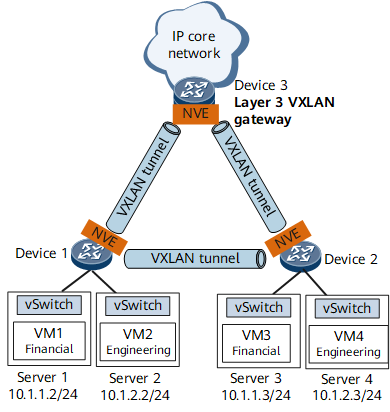Application for Communication Between Terminal Users on a VXLAN
Service Description
Currently, data centers are expanding on a large scale for enterprises and carriers, with increasing deployment of virtualization and cloud computing. In addition, to accommodate more services while reducing maintenance costs, data centers are employing large Layer 2 and virtualization technologies.
As server virtualization is implemented in the physical network infrastructure for data centers, VXLAN, an NVO3 technology, has adapted to the trend by providing virtualization solutions for data centers.
Networking Description
On the network shown in Figure 1, an enterprise has VMs deployed in different data centers. Different network segments run different services. The VMs running the same service or different services in different data centers need to communicate with each other. For example, VMs of the financial department residing on the same network segment need to communicate, and VMs of the financial and engineering departments residing on different network segments also need to communicate.
Feature Deployment
- Deploy Device 1 and Device 2 as Layer 2 VXLAN gateways and establish a VXLAN tunnel between Device 1 and Device 2 to allow communication between terminal users on the same network segment.
- Deploy Device 3 as a Layer 3 VXLAN gateway and establish a VXLAN tunnel between Device 1 and Device 3 and between Device 2 and Device 3 to allow communication between terminal users on different network segments.
Configure VXLAN on devices to trigger VXLAN tunnel establishment and dynamic learning of ARP and MAC address entries. By now, terminal users on the same network segment and different network segments can communicate through the Layer 2 and Layer 3 VXLAN gateways based on ARP and routing entries.
